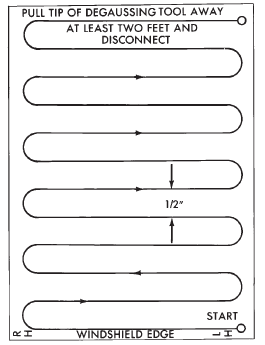Jeep Cherokee (XJ): Service procedures
Variance is the difference between magnetic north
and geographic north. In some geographic locations,
the difference between magnetic and geographic
north is great enough to cause the compass to give
false readings. If this problem occurs, the compass
variance must be set.
To set the compass variance:
(1) Using the Variance Settings map, find your
geographic location and note the zone number (Fig.
1).
(2) Turn the ignition switch to the On position. If
the compass/temperature data is not currently being
displayed, momentarily depress and release the Step
button to step through the display options until you
have reached the compass/temperature display.
(3) Depress both the U. S./Metric, and the Step
buttons. Hold the buttons down until "VAR" appears
in the display. This takes about five seconds.
(4) Release both of the buttons. The current variance
zone number setting will appear in the display.
(5) Press and release the U. S./Metric button to
step through the zone numbers, until the zone number
for your geographic location appears in the display.
(6) Press the Step button to enter this zone number
into the compass unit memory.
(7) Confirm that the correct directions are now
indicated by the compass. CAUTION: Do not place any external magnets, such
as magnetic roof mount antennas, in the vicinity of
the compass. Do not use magnetic tools when servicing
the overhead console.
The electronic compass unit features a self-calibrating
design, which simplifies the calibration procedure.
This feature automatically updates the
compass calibration while the vehicle is being driven.
This allows the compass unit to compensate for small
changes in the residual magnetism that the vehicle
may acquire during normal use. Do not attempt to
calibrate the compass near large metal objects such
as other vehicles, large buildings, or bridges.
NOTE: Whenever the compass is calibrated manually,
the variation number must also be reset. See
Compass Variation Adjustment in the Service Procedures
section of this group.
Calibrate the compass manually as follows:
(1) Start the engine. If the compass/temperature
data is not currently being displayed, momentarily
depress and release the Step button to step through
the display options until you have reached the compass/
temperature display.
(2) Depress both the U. S./Metric and the Step
buttons. Hold the buttons down until "CAL" appears
in the display. This takes about ten seconds, and
appears about five seconds after "VAR" is displayed.
(3) Release both of the buttons.
(4) Drive the vehicle on a level surface, away from
large metal objects, through three or more complete
circles in not less than 48 seconds. The "CAL" message
will disappear from the display to indicate that
the compass is now calibrated. NOTE: If the "CAL" message remains in the display,
either there is excessive magnetism near the
compass, or the unit is faulty. Repeat the demagnetizing
and calibration procedures at least one more
time.
NOTE: If the wrong direction is still indicated in the
compass display, the area selected for calibration
may be too close to a strong magnetic field. Repeat
the calibration procedure in another location. A degaussing tool (Special Tool 6029) is used to
demagnetize, or degauss, the overhead console forward
mounting screw(s) and the roof panel. Equivalent
units must be rated as continuous duty for 110/
115 volts and 60 Hz. They must also have a field
strength of over 350 gauss at 7 millimeters (0.25
inch) beyond the tip of the probe.
To demagnetize the roof panel and the overhead
console forward mounting screw(s), proceed as follows:
(1) Be certain that the ignition switch is in the Off
position, before you begin the demagnetizing procedure.
(2) Plug in the degaussing tool, while keeping the
tool at least 61 centimeters (2 feet) away from the
compass unit.
(3) Slowly approach the head of the overhead console
forward mounting screw with the degaussing
tool plugged in.
(4) Contact the head of each screw with the plastic
coated tip of the degaussing tool for about two seconds.
(5) With the degaussing tool still energized, slowly
back it away from the screw. When the tip of the tool
is at least 61 centimeters (2 feet) from the screw
head, unplug the tool.
(6) Place a piece of paper approximately 22 by 28
centimeters (8.5 by 11 inches), oriented on the vehicle
lengthwise from front to rear, on the center line of
the roof at the windshield header (Fig. 2). The purpose
of the paper is to protect the roof panel from
scratches, and to define the area to be demagnetized.
(7) Plug in the degaussing tool, while keeping the
tool at least 61 centimeters (2 feet) away from the
compass unit.
(8) Slowly approach the center line of the roof
panel at the windshield header, with the degaussing
tool plugged in.
(9) Contact the roof panel with the plastic coated
tip of the degaussing tool. Be sure that the template
is in place to avoid scratching the roof panel. Using a
slow, back-and-forth sweeping motion, and allowing
13 millimeters (0.50 inch) between passes, move the
tool at least 11 centimeters (4 inches) to each side of
the roof center line, and 28 centimeters (11 inches)
back from the windshield header.
(10) With the degaussing tool still energized,
slowly back it away from the roof panel. When the
tip of the tool is at least 61 centimeters (2 feet) from
the roof panel, unplug the tool.
(11) Calibrate the compass and adjust the compass
variance as described in the Service Procedures section
of this group.Compass variation adjustment

Fig. 1 Variance SettingsCompass calibration
Compass demagnetizing

Fig. 2 Roof Demagnetizing Pattern
Other materials:
Description and operation
8 1/4 Axle
DESCRIPTION
The 8 1/4 inch axle housings consist of a cast iron
center section with axle tubes extending from either
side. The tubes are pressed into and welded to the
differential housing to form a one-piece axle housing
(Fig. 1).
The axles have a vent hose to relieve internal pr ...


